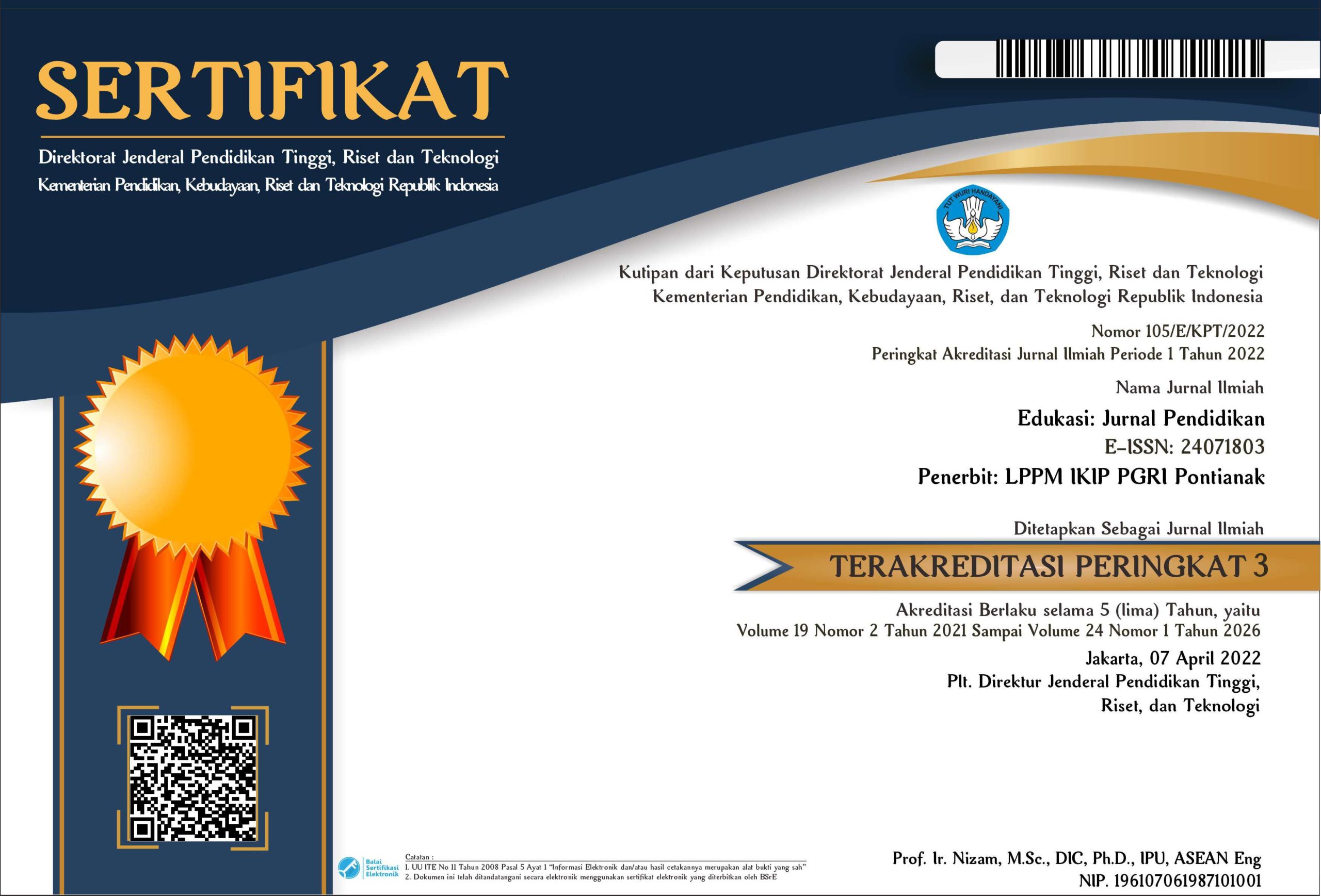Analisis Gender dan Intellectual Intelligence terhadap Kreativitas
DOI:
https://doi.org/10.31571/edukasi.v18i2.1847Keywords:
kreativitas, intellectual intelligence, gender, korelasi, creativity, correlationAbstract
Abstrak
Penelitian bertujuan untuk mengetahui hubungan antara perbedaan gender dan intellectual intelligence terhadap kreativitas siswa sekolah dasar. Sampel penelitian berjumlah 60 siswa yang dipilih secara simple random sampling. Instrumen yang digunakan yaitu Coloured Progressive Matrices dan Figural Creativity Test untuk menentukan tingkat intellectual intelligence dan kreativitas siswa. Teknik analisis data menggunakan analisis korelasi. Hasil analisis menunjukkan bahwa: kemampuan intellectual intelligence berkaitan dengan kemampuan untuk berkreativitas; tidak ditemukan perbedaan gender terhadap kemampuan berkreativitas; dan analisis korelasi berganda terhadap kemampuan intellectual intelligence dan perbedaan gender menunjukkan tidak ada hubungan dengan kemampuan kreativitas siswa.
Â
Abstract
The research aimed to determine the relationship between gender differences and intellectual intelligence on the creativity of elementary school students. The research sample consisted of 60 students who were selected by simple random sampling. The instruments used were Colored Progressive Matrices and Figural Creativity Test to determine the level of intellectual intelligence and creativity of students. The data analysis technique used correlation analysis. The results of the analysis showed that: intellectual intelligence ability was related to the ability to be creative; no gender differences were found on creativity skills, and multiple correlation analysis on intellectual intelligence abilities and gender differences showed no relationship with students' creative abilities.
Downloads
References
Abraham, A. 2015. Gender and Creativity: An Overview of Psychological and Neuroscientific Literature. Brain Imaging and Behavior, 10(2): 609-618.
Abraham, A., Thybusch, K., & Pieritz, K. 2013. Gender Differences in Creative Thinking: Behavioral and FMRI Findings. Brain Imaging and Behavior, 8(1): 39-51.
Arpan, M., Sulistiyarini, D., & Santoso, D. 2016. Effect of Motivation and Creativity on Students' Psychomotor Ability. Journal of Education, Teaching and Learning, 1(2): 71-75.
Baer, J. 2010. Gender Differences in the Effects of Anticipated Evaluation on Creativity. Creativity Research Journal, 10(1): 37-41.
Baer, J. & Kaufman, J. C. 2008. Gender Differences in Creativity. Journal of Creative Behavior, 42(2): 75-105.
Benedek, M., Jauk, E., Sommer, M., Arendasy, M., & Neubauer, A. C. 2014. Intelligence, Creativity, and Cognitive Control: The Common and Differential Involvement of Executive Functions in Intelligence and Creativity. Intelligence, 46(1):73-83.
Cassia, T. D., Pontificia, N., Catolica, U., & Paulo, S. 2015. Intelligence and Creativity: Relationships and Their Implications for Positive Psychology. Psico-USF Bragança Paulista, 20(2): 195-206.
Cheung, P. C. & Lau, S. 2010. Gender Differences in the Creativity of Hong Kong School Children: Comparison by Using the New Electronic Wallach – Kogan Creativity Tests. Creativity Research Journal, 22(2):194-199.
Dariyo, A. 2008. Psikologi Perkembangan Dewasa Muda. Jakarta: Gramedia.
Guignard, J., Kermarrec, S., & Tordjman, S. 2015. Relationships between Intelligence and Creativity in Gifted. Learning and Individual Differences, 52(C): 209-215.
He, W. & Wong, W. 2011. Gender Differences in Creative Thinking Revisited: Findings from Analysis of Variability. Personality and Individual Differences, 51(7): 807-811.
Hendrik, B., Ali, N. M., & Nayan, N. M. 2020. Robotic Technology for Figural Creativity Enhancement: Case Study on Elementary School. International Journal of Advanced Computer Science and Applications, 11(1): 536-543.
Hendrik, B., Ali, N. M., Sulaiman, R., Masril, M., & Fikri, H. T. 2019. Relationship between Intellectual Intelligence, Figural Creativity, and Innovation. Advances in Social Science, Education and Humanities Research, 229(1): 545-555.
Kim, K. H. 2011. The Creativity Crisis: The Decrease in Creative Thinking Scores on the Torrance Tests of Creative Thinking. Creativity Research Journal, 23(4): 285-295.
Lin, W., Chen, H., & Wang, J. 2012. The Relations of Gender and Personality Traits on Different Creativities: A Dual-Process Theory Account. Psychology of Aesthetics, Creativity, and the Arts, 6(2): 112-123.
Masril, M., Hendrik, B., Fikri, H. T., Hazidar, A. H., Priambodo, B., Naf'an, E., Handriani, I., Putra, Z. P., & Nseaf, A. K. 2019. The Effect of Lego Mindstorms as an Innovative Educational Tool to Develop Students’ Creativity Skills for a Creative Society. Journal of Physics: Conference Series, 1339(2019): 1-9.
Munandar, U. 1999. Pengembangan Kreativitas Anak Berbakat. Jakarta: Rineka Cipta.
Pierson, E. E., Kilmer, L. M., Rothlisberg, B. A., & Mcintosh, D. E. 2012. Tests in the Identification of Giftedness. Journal of Psychoeducational Asessment, 30(1): 10-24.
Plucker, J. A. & Esping, A. 2015. Intelligence and Creativity: A Complex but Important Relationship. Asia Pacific Education Review, 16(2): 153-159.
Potur, A. A. & Barkul, O. 2009. Gender and Creative Thinking in Education: A Theoretical and Experimental Overview. A|Z ITU Journal of Faculty of Architecture, 6(2): 44-57.
Proudfoot, D., Kay, A. C., Koval, C. Z., Hitchcock, A., Dylan, B., & Wright, F. L. 2015. A Gender Bias in the Attribution of Creativity: Archival and Experimental Evidence for the Perceived Association Between Masculinity and Creative Thinking. Psychological Science, 26(11): 1751-1761.
Sayed, E. M., Hassan, A., & Mohamed, H. 2013. Gender Differences in Divergent Thinking: Use of the Test of Creative Thinking-Drawing Production on an Egyptian Sample. Creativity Research Journal, 25(1): 37-41.
Tyler, L. E. 1956. The Psychology of Human Differences. New Work: Appleton.
Ulger, K. & Morsunbul, U. 2016. The Differences in Creative Thinking : The Comparison of Male and Female Students. The Online Journal of Counseling and Education, 5(4): 1-12.
Wechsler, D. 1958. The Measurement and Appraisal of Adult Intelligence. Baltimore: Williams and Wilkins.
Williams, R. L. 2013. Intelligence Overview of the Flynn Effect. Intelligence, 41(6): 753-764.
Downloads
Published
How to Cite
Issue
Section
License
Authors who publish in this journal agree to the following terms:
- Authors retain copyright and grant the journal the right of first publication with the work simultaneously licensed under a Creative Commons Attribution License (CC-BY-NC) that allows others to share the work with an acknowledgment of the work's authorship and initial publication in this journal.
- Authors are able to enter into separate, additional contractual arrangements for the non-exclusive distribution of the journal's published version of the work (e.g., post it to an institutional repository or publish it in a book), with an acknowledgment of its initial publication in this journal.
- Authors are permitted and encouraged to post their work online (e.g., in institutional repositories or on their website) prior to and during the submission process, as it can lead to productive exchanges, as well as earlier and greater citation of published work.















